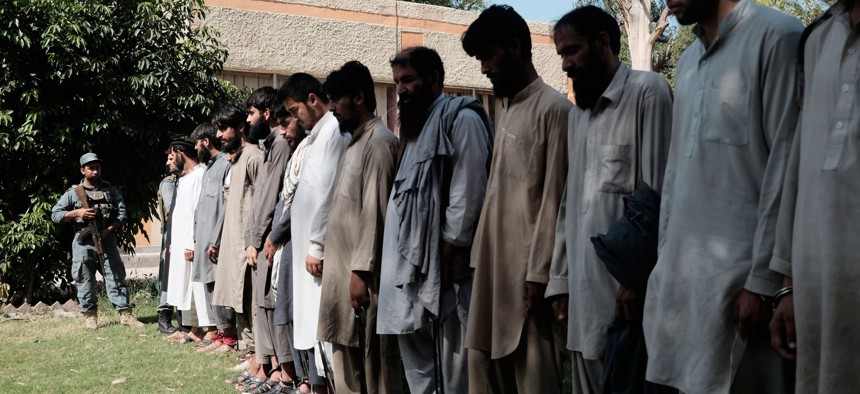
Islamic State fighters, who were arrested by Afghan security personal are presented to the media at the Afghan police headquarters in Jalalabad, east of Kabul, Afghanistan, Monday, May 9, 2016. Mohammad Anwar Danishyar/AP
To Beat ISIS, We Must Think Smaller
People become radicalized when they lack hope, jobs, and purpose. Local investments can break the cycle.
Last month, the United Nations held a large conference in Geneva to discuss its plan to prevent violent extremism; that same day in Washington, D.C., two federal contractors with experience in peacebuilding held a conference on the same subject, at which DHS Secretary Johnson and Sen. Cory Booker delivered remarks. Our own non-profit presented at the latter event; we spoke about how to use data in programs to prevent radicalization among people who may join groups like ISIL. Yet there was an elephant in each of these elegant conference rooms.
For all the lip service given to breaking the cycle of radicalization where it starts—at the local level—the global leaders on the topic have done almost nothing to empower such action.
We know enough about recruitment for ISIS and its ilk to know that there is no single way individuals radicalize. We also know it involves some combination of ideological, psychological, and community-based factors. People flocking to Syria to join terrorist groups tend to be radical before they are religious, and tend to be motivated more by seeking personal agency than by any lofty ideology. Our work involves looking at these local community factors through the eyes of community members, using data to map the lifecycle of recruitment to violence, looking at the root causes among community factors.
For example, we asked people in the small Philippines village of Barira what their community’s problems were and what should be done to solve them. As we gathered data, a story became clear. Young men are pulled out of school to work unsustainable farming jobs, the girls grow up and move out of the community for college, the young men grow up with unsustainable jobs and no education. They feel hopeless and seek drugs to dull the pain, and then they fill that void of hopelessness, gaining personal agency by joining local violent groups who offer them a sense of purpose—and sometimes incentives to fuel their addictions. (Read our report.)
Some people think it’s strange—a former special operations soldier turned USAID officer and technology advisor has paired with a former State Department and White House official to stand up an agricultural co-op in a small village in the Southern Philippines. But those who understand radicalization and data can see why—the community pointed us to inefficient grain production processes as the root cause that triggers the domino effect of a lifecycle of recruitment to violence.
At the same time, global leaders keep having the same conversation: that we should care about the causes of radicalization. But it is time to turn talk into action. Only six percent of federal funding related to terrorism goes to our diplomatic and development communities, and less than eight percent of that funding is used for prevention efforts similar to ours. Programming tends to have an indirect relationship with data, at best, so it is hard to say whether programs are targeted to community needs or whether success can be measured. Meanwhile, private foundations continue to be spooked by the early days of terrorism as a global priority, continuing to (erroneously) believe anything related to terrorism involves spying or bombs. So the funding for prevention activities, known as Countering Violent Extremism (CVE), is rare, narrowly scoped, and seldom targeted through high quality data.
See also: Leave Root Causes Aside—Destroy the ISIS ‘State’
Related: America Can’t Do Much About ISIS
As Sen. Booker said at the CVE Symposium, which was sponsored by the International Peace and Security Institute and Creative Associates, “In God I trust…everyone else show me data.” We agree—but how can people in the field, like we are, do that when data fails to be a fundamental part of international development, whose funds are small to begin with?
Soon, our non-profit, the impl. project, will be buying a solar dryer for the desperate people in Barira. It will cost $6,000. Meanwhile, the military effort to counter ISIL currently costs $11.6 million per day, and will do little or nothing to break the long-term cycle of radicalization that has made our struggle against terrorism a generational one. It may even exacerbate the problem by accidentally feeding a narrative that the West is at war with Islam.
We were pleased to contribute to the recent conference, but we need more than conferences now—we need concrete action, and an industry supported by both private and public funding to truly address the root causes of violence.
NEXT STORY: Transparency’s Double-Edged Sword




